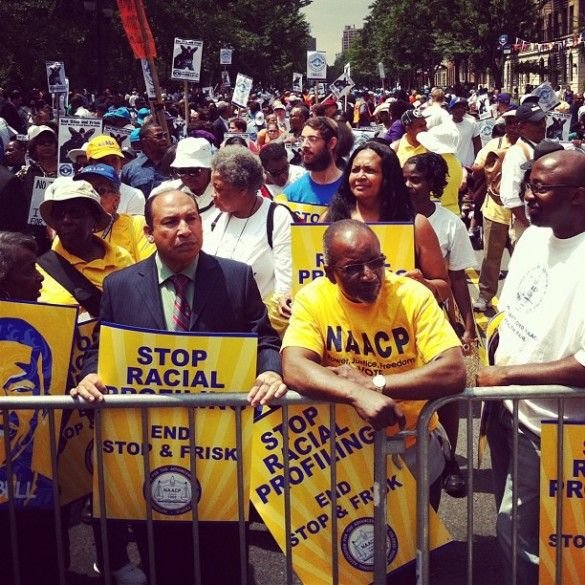Op-Ed: Stop-And-Frisk In Need Of Repair-And-Reform

BETWEEN THE LINES: After a violent post-July 4th weekend and more violence in the ensuing days, the debate over the New York City Police Department’s controversial stop-and-frisk policy has figuratively become hotter than the summer’s heat waves.
Despite the recent flurry of shootings, the last four years have been the safest in New York’s history, according to a mayoral spokesman.
While the statistics are alarming — up from 47 shootings last year to 62 this year for the July 6-8 period — last year’s numbers seem uncommonly high, but I don’t recall anyone being upset when nearly four dozen people were shot in 2011.
Lots of statistics have been bandied about from both sides trying to defend or attack the stop-and-frisk argument. Some have even attributed the recent violence spike to the hotter-than-normal summer we’ve been experiencing. Historically, violence typically spikes during heat waves.
While the recent escalation of violence certainly has no particular motive, the NYPD should instigate changes to stop-and-frisk before the courts force it on them. As it is, federal and state court judges have recently criticized the NYPD, citing, among other violations, the U.S. Constitution’s Fourth Amendment prohibition against “unreasonable searches,” as well as “reasonable suspicion” — however those vague terms are interpreted by officers on the mean streets.
A Federal District Court judge recently blamed NYPD brass for its policy of “establishing and demanding increased levels of stop-and-frisks.” That statement is supported by former cops who have revealed that — like traffic ticket quotas, which the NYPD has never acknowledged — precinct commanders also strongly recommend stop-and-frisk quotas for officers.
Mayor Michael Bloomberg has criticized the courts’ rulings and NYPD Commissioner Ray Kelly has vowed to continue the controversial policy, which he views as a deterrent to potential crime. Kelly said, “You hear all the time from people who don’t like stop-and-frisk. But you know what people really hate in New York City, and always have? Guns.”
But, the actual numbers don’t gibe with Kelly’s statement and demonstrate the ineffectiveness of stop-and-frisk. According to various media reports, of the nearly 700,000 stop-and-frisks last year, 90 percent were neither ticketed nor arrested.
Using NYPD data, the New York City Liberties Union (NYCLU) found that in 685,000 stop-and-frisk incidents last year, the police recovered a weapon in less than two percent of the cases (a total of 780) when they actually conducted a frisk, and only six percent of stops led to arrests.
That’s a negligible result for violating New Yorkers’ rights.
The Fourth Amendment’s prohibition against “unreasonable search and seizures” without “probable cause” and the lesser standard of “reasonable suspicion,” established in a 1968 Supreme Court decision, applies to the New York Police Department, but it seems New York’s Finest, more often than not, exercise the policy as a justification, regardless of cause.
Unless the NYPD can rationalize the excessive number of stop-and-frisks with trivial results, what they are doing is illegal and any violation of the law is criminal. When law enforcement breaches the law to enforce it, it is time to restrain that authority.
Weather notwithstanding, the debate over the NYPD’s stop-and-frisk policy has heated up. Perhaps it’s time for police officials to sit down with responsible leaders and members of the neighborhoods where the strategy occurs most frequently to discuss and/or defend their grievances. If not, the atmosphere of mistrust between minorities and police could reach a boiling point that could be difficult to calm.
As Chief Justice Earl Warren wrote about problematic searches in the 1968 Supreme Court case, Terry vs. Ohio, “It is a serious intrusion upon the sanctity of the person, which may inflict great indignity and arouse strong resentment, and is not to be undertaken lightly.”
The city’s dramatic drop in crime over the last 20 years reflects first-rate police strategy by a department that has lost thousands of officers. While the controversial program may have benefits, it does not give police officers sovereignty to stop, question and search anyone they consider suspicious — whatever that means — since it appears to be racially motivated.
In the vigilant pursuit to contain and investigate crime, police should never overstep the bounds of their authority. Furthermore, in order to preserve a constructive relationship with the communities they serve, courtesy and respect are important ingredients of their vocation.
Stop-and-frisk abuses must be curtailed and its tactics improved. Police cannot be allowed to stop an individual whenever they don’t like the way that person looks. Though highly controversial, at best, stop-and-frisk may foil potential crimes, but, at worst, it is a clear violation of personal freedom.
First and foremost, even in the dogged pursuit of public safety, individual liberty must never be compromised out of fear.
Neil S. Friedman is a veteran reporter and photographer, and spent 15 years as an editor for a Brooklyn weekly newspaper. He also did public relations work for Showtime, The Rolling Stones and Michael Jackson. Friedman contributes a weekly column called “Between the Lines” on life, culture and politics in Sheepshead Bay.
Disclaimer: The above is an opinion column and may not represent the thoughts or position of Sheepshead Bites. Based upon their expertise in their respective fields, our columnists are responsible for fact-checking their own work, and their submissions are edited only for length, grammar and clarity. If you would like to submit an opinion piece or become a regularly featured contributor, please e-mail nberke [at] sheepsheadbites [dot] com.




